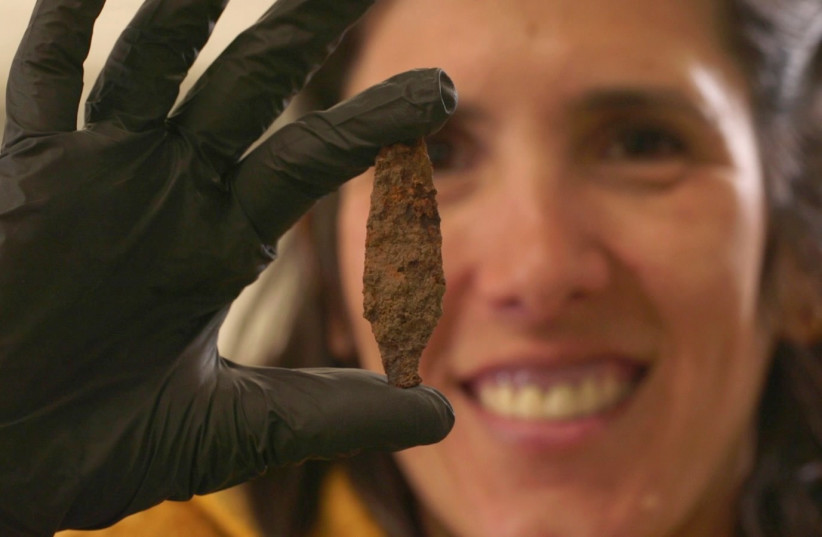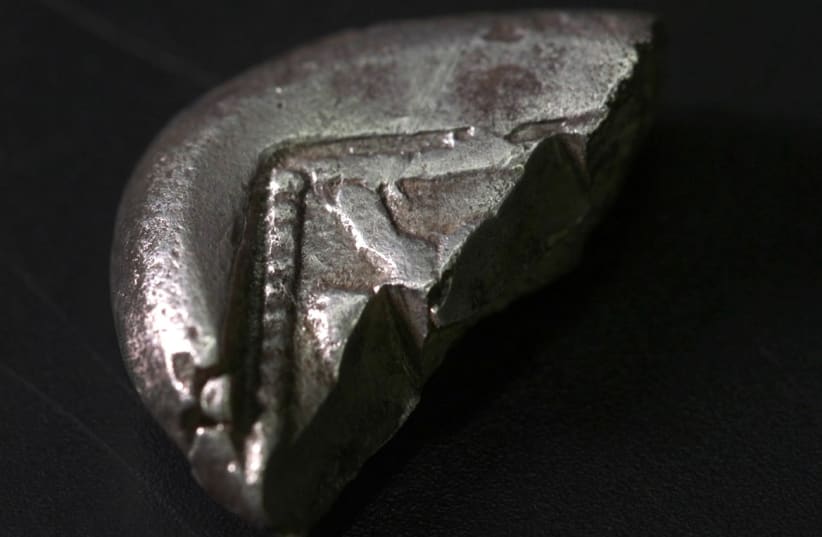An extremely rare silver coin that was minted outside the Land of Israel during the Persian Period – within a few centuries of the biblical story of Queen Esther and King Ahasuerus in the 6th–5th centuries BCE – has been discovered by an archaeologist during an Israel Antiquities Authority (IAA) excavation in the Judean Hills.
But it was not minted in Persia, and it was certainly not used by the royal pair to buy something to drink from a vending machine. Minted in a period when the use of coins had just begun, it joins only half a dozen coins of its type that have been found in excavations in the country.
An indication of the gradual process of minting coins instead of weighing silver pieces to make payments for goods purchased is the fact that, although the coin was minted as such, it was found intentionally cut into two.
This indicates that in the 4th century BCE, it was used as a weighed piece of silver rather than as a coin, even though coins were current in this period.
The rare coin was discovered by Semyon Gendler, the IAA’s acting Judean District archaeologist. It was minted with a square stamp embedded into one face; later, more sophisticated techniques produced coins with protruding rather than sunken stamps.


Gendler found it during an excavation funded by the Netivei Yisrael National Transport Infrastructure Company.
Additional findings
A few weeks ago, the same excavation exposed a building from the First Temple Period, with even earlier evidence for commerce in the form of a shekel weight in a building dating to the time of the Kingdom of Judah.
A characteristic “four-room house” was uncovered from this period, and the shekel weight, found on the floor of one of the rooms in the house, provides early evidence for trade. The dome-shaped stone weight would have been used for weighing metals, spices, and other expensive commodities. The sign on the weight was an ancient Egyptian (hieratic, or abridged hieroglyphics used by priests) abbreviation for the word shekel, and the single incised stroke represents one shekel.
According to Dr. Robert Kool, head of the IAA’s numismatic department, “The rare find contributes information concerning the way trade was carried out and the process whereby global commerce moved from payment by weighing silver pieces to the use of coins.
The coin belongs to a group of very early coins that were minted outside Israel, in the regions of ancient Greece, Cyprus, and Turkey. In the 6th to 5th centuries BCE, such coins began to appear at sites in the Land of Israel.
According to IAA excavation directors Michal Mermelstein and Danny Benayoun, “the site was situated in the rural area of the Kingdom of Judah, whose capital was in Jerusalem. It was first settled in the First Temple period, in the 7th century BCE (2,700 years ago), during the reigns of the kings of Judah, Hezekiah, Manasseh, Amon and Josiah, a peak settlement period in the kingdom of Judah.
The weight weighs 11.07 g. “This was in effect a standard weight in the region of the kingdom of Judah, showing that commodities were carefully weighed in the markets,” the archaeologists noted.
Moriya Reef, an engineer and southern region projects department manager for Netivei Yisrael, said: “We began the substantial project on Highway 375 for expanding into a two-lane, two-way highway, eight kilometers long, including arranging junctions and expanding the existing underpasses on the route.
"We fully recognized that this area required collaboration with the IAA for the possibility of discovering archeological findings at any point throughout the job site," Reef said.
"We enabled them to conduct their work parallel to the progress on the highway, and there is no doubt that its findings are amazing. The thought that discovering such important and meaningful findings – thanks to initiating an infrastructure project – is undoubtedly quite exciting".
According to IAA director Eli Escuzido, “It is always surprising how important findings are discovered in unexpected places. The tiny coins are a crucial source of information in archaeology. They provide us visual details, inscriptions, and dates.
Through a tiny object like a coin, it becomes possible to trace human thought processes and observe that our economic habits have remained largely unchanged for thousands of years – only the technology has changed. In this context, it is interesting to consider future archaeological research in a world that has adopted electronic commerce.”
